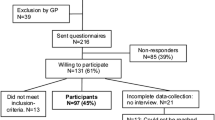Abstract
From 1987 to 1991, over 36,000 men and women aged 20‐59 years have been examined in the Monitoring Project on Cardiovascular Disease Risk Factors in The Netherlands. Classification of the treatment status of hypertensives in this population‐based study was based on self‐administered questionnaires. In order to assess the accuracy of self‐reported antihypertensive drug use we compared the questionnaire information with computerized pharmacy records from a sample of 372 hypertensive subjects. Most antihypertensive drugs that were mentioned in the questionnaire were present in the pharmacy medication history (93%). However, this percentage was less (76%) when a comparison was made with the calculated duration of use based on the number of units prescribed and the directions for use in the pharmacy records. About 94% of the hypertensive subjects who were using an antihypertensive drug according to the pharmacy records, also mentioned at least one antihypertensive drug in the questionnaire. Agreement between self‐reported antihypertensive drug use and pharmacy records was consistently high for all classes of antihypertensive drugs. Among 321 (86%) subjects, the number and types of self‐reported antihypertensive drugs were exactly the same as in the pharmacy records. In conclusion, the agreement between self‐reported antihypertensive drug use and pharmacy records was high, and the self‐reported questionnaire information on antihypertensive drug use can be reliably used for the classification of treatment status of hypertensive subjects in this population‐based study.
Similar content being viewed by others
References
Burt VL, Cutler JA, Higgins M, et al. Trends in the Prevalence, awareness, treatment, and control of hypertension in the adult US population. Data from the Health Examination Surveys, 1960 to 1991. Hypertension 1995;26:60-9.
Project TWM. Geographical variation in the major risk factors of coronary heart disease in men and women aged 35-64 years. Wld Hlth Statist Quart 1988;41:115-39.
Verschuren WMM, Leer van EM, Blokstra A, et al. Cardiovascular disease risk factors in The Netherlands. Neth J Cardiol 1993;6:205-10.
Hofman A, Grobbee DE, de Jong PT, van den Ouweland FA. Determinants of disease and disability in the elderly: the Rotterdam Elderly Study. Eur J Epidemiol 1991;7:403-22.
Johnson RE, Vollmer WM. Comparing sources of drug data about the elderly. J Am Geriatr Soc 1991; 39:1079-84.
Paganini-Hill A, Ross RK. Reliability of recall of drug usage and other health-related information. A J Epidemiol 1982;116: 114-22.
Van den Brandt PA, Petri H, Dorant E, Goldbohm RA, Crommert van de S. Comparison of questionnaire information and pharmacy data on drug use. Pharm Weekbl Sci 1991;13:91-6.
West SL, Savitz DA, Koch G, Strom BL, Huess HA, Hartzema A. Recall accuracy for prescription medications: Self-report compared with database information. A J Epidemiol 1995;142:1103-12.
Rosenberg MJ, Layde PM, Ory HW, Strauss LT, Rooks JB, Rubin GL. Agreement between women's histories of oral contraceptive use and physician records. Int J Epidemiol 1983;12:84-7.
Stolley PD, Tonascia JA, Sartwell PE, et al. Agreement rates between oral contraceptive users and prescribers in relation to drug use histories. Am J Epidemiol 1978;107:226-35.
Goodman MT, Nomura AM, Wilkens LR, Kolonel LN. Agreement between interview information and physician records on history of menopausal estrogen use. Am J Epidemiol 1990;131:815-25.
Schwarz A, Faber U, Borner K, Keller F, Offerman G, Molzahn M. Reliability of drug history in analgesic users. Lancet 1984;2:1163-4.
Sjahid SI, van der Linden PD, Stricker BH. Agreement between the pharmacy medication history and patient interview for cardiovascular drugs: the Rotterdam elderly study. Br J Clin Pharmacol 1998;45:591-5.
Psaty BM, Lee M, Savage PJ, Rutan GH, German PS, Lyles M. Assessing the use of medications in the elderly: Methods and initial experience in the cardiovascular health study. J Clin Epidemiol 1992;45:683-92.
Klungel OH, Boer de A, Paes AHP, Seidell JC, Nagelkerke NJD, Bakker A. Undertreatment of hypertension in a populationbased study in The Netherlands. J Hypertens 1998;16:1371-8.
Anonymous. Guidelines for ATC classification. Oslo: WHO Collaborating centre for drug statistics methodology-Nordic Council on medicines, 1990.
Herings RMC. PHARMO; a record linkage system for post-marketing surveillance of prescription drugs in the Netherlands. Utrecht: Utrecht University, 1993.
Leufkens. Pharmacy records in pharmacoepidemiology: studies on antiinflammatory and antirheumatic drugs. Utrecht: Utrecht University, 1990.
Lau HS, de Boer A, Beuning KS, Porsius A. Validation of pharmacy records in drug exposure assessment. J Clin Epidemiol 1997;50:619-25.
Heerdink ER, Leufkens HG, Koppedraaijer C, Bakker A. Information on drug use in the elderly: a comparison of pharmacy, general-practitioner and patient data. Pharm World Sci 1995;17:20-4.
Visser LE, Stricker BHC, Velden van der J, Paes AHP, Bakker A. Angiotensin converting enzyme inhibitor associated cough: a population-based case-control study. J Clin Epidemiol 1995;48:851-7
Cohen J. A coefficient of agreement for nominal scales. Educ Psychol Meas 1960;20:37-46.
Fleiss JL, Cohen J, Everitt BS. Large sample errors of kappa and weighted kappa. Psychol Bull 1969;72:323-7.
Landis JR, Koch GG. The measurement of observer agreement for categorical data. Biometrics 1977;33:159-84.
Rights and permissions
About this article
Cite this article
Klungel, O.H., de Boer, A., Paes, A.H. et al. Agreement between self‐reported antihypertensive drug use and pharmacy records in a population‐based study in The Netherlands. Pharm World Sci 21, 217–220 (1999). https://doi.org/10.1023/A:1008741321384
Issue Date:
DOI: https://doi.org/10.1023/A:1008741321384




